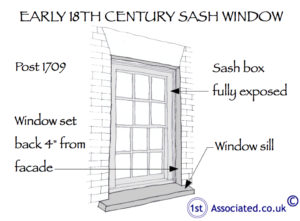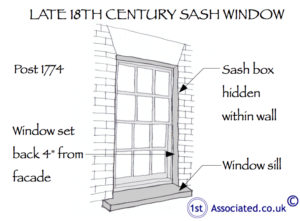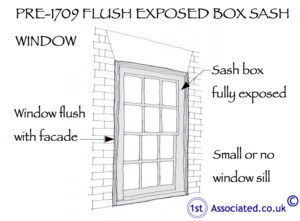Charles Brooking
Charles Brookings' 21st birthday present and being banned from
collecting / rescuing windows, doors and staircases
Charles Brooking is a fascinating and knowledgeable collector of architectural detail, The Brooking Collection of Architectural Detail, and as Independent Surveyors we find his lifelong quest to collect British building details unique, informative and valuable and a collection that must be kept intact for years to come. If you need help and advice with regard to building surveys, structural surveys, structural reports, engineers reports, specific defects report, dilapidations or any other property matters please free phone 0800 298 5424.

The following is one of a series of interviews with Charles Brooking, Historic and Listed Buildings Detail Expert, The Brooking Collection of Architectural Detail and a Surveyor where we have recorded his comments and various aspects that have affected windows and doors and other collectibles. The interviews outline how his collection started and built over the years and gives an insight into the amazing architectural features housed in his fine collection.
 Surveyor: When did The Brooking Collection of Architectural Detail really start?
Surveyor: When did The Brooking Collection of Architectural Detail really start?
Charles Brooking: It was actually on my 21st birthday in 1974. I was going up to The Savoy with my father and to his horror he noticed that I had spotted the demolition by Griffiths of the internal structure of this massive triangular site. (My mother actually had a shop there with her guardian, St Martin's Gallery, between 1927 and 1951, so I was familiar with that street, William IV Street). The Coutts bank building itself replaced the Lowther Arcade of 1830-31with the demolition meaning that the Coutts Bank site was going completely demolishing those facades and Frederick Gibble was going to recess the glass facades, preserve the Pepper Pots and the facades of the West Strand improvements themselves and gut out everything - I saw this and thought it was an opportunity to salvage some architectural details.
Rescue defined
Charles Brooking defines a rescue as saving a window or door or staircase that would be doomed.
Charles Brooking was a pioneer in the rescue of architectural detailing as many years ago it was very much considered a strange and an unusual past time to want to rescue old parts of buildings with everything new and shiny being so important.
 So, I skipped off my job at (name withheld!) and I went to see the site foreman of the building contractors. He let me go round and I realised many of the rooms had attained their original Curren registered grates their original sash windows with crown glass and fasteners fittings, architraves, door details, the original curved windows in the Pepper Pots etc.
So, I skipped off my job at (name withheld!) and I went to see the site foreman of the building contractors. He let me go round and I realised many of the rooms had attained their original Curren registered grates their original sash windows with crown glass and fasteners fittings, architraves, door details, the original curved windows in the Pepper Pots etc.
I had a real problem as my parents actually banned me from collecting. It was very difficult because all this marvellous stuff was going to be destroyed.
Surveyor: How much did you collect?
Charles Brooking: Well, it was very difficult indeed; a lot, but it was still very small compared with a few years later. I had the back of my parents' garage pretty well crammed with doors, windows and features from Guildford. I had two displayed buildings in the garden; one put up on my 15th birthday and the second in November '71, but it was a real problem.
I had met a very nice chap, who was a banker, who was there rescuing bits for himself from the Bank and he showed me the unusual sash pulleys made by Gibbons of Wolverhampton, that marvellous firm, James Gibbons. It was designed by Vicker Anderson of Coutts Bank 1904. He said that he would help me store stuff so I helped him rescue stuff; he had a van outside. We loaded up as much as we could that day and I went back for the next six weeks, every Sunday, getting in on a Sunday because no-one was around and they didn't mind me going on site, because the director was quite concerned about people going in. I could have got in through the construction company and my father was agreeable but he wasn't going to pay for my collecting then unfortunately.
 One day I skipped work to go up there in the week and my father rang my mother saying do you know that Charles is in The Strand in the Pepper Pot site? On my return home my mother questioned my whereabouts and was disgusted I had skived off work in search of adding to my architectural detailing collection. I had managed to retrieve examples of Carron hob grates, made by Carron of Falkirk from the 1830's, hob grates sash windows, typical of the 1820's, internal glazed sashes from The Strand, a wide ranging collection of late Regency door furniture, architraves and mouldings so to me a day off work had reaped many fine finds.
One day I skipped work to go up there in the week and my father rang my mother saying do you know that Charles is in The Strand in the Pepper Pot site? On my return home my mother questioned my whereabouts and was disgusted I had skived off work in search of adding to my architectural detailing collection. I had managed to retrieve examples of Carron hob grates, made by Carron of Falkirk from the 1830's, hob grates sash windows, typical of the 1820's, internal glazed sashes from The Strand, a wide ranging collection of late Regency door furniture, architraves and mouldings so to me a day off work had reaped many fine finds.
Later on in 1976 I managed to get permission to remove the curved sash windows from the Pepper Pot itself, or the Pepper Pots facing towards Trafalgar Square , where Brunel had his office in the 1840's.
 Surveyor: Do you still have all these in your collection?
Surveyor: Do you still have all these in your collection?
Charles Brooking: I do. Some were stored at Greenwich University some at the Greenwich Museum and one or two are down here at my Surrey museum they are now in storage awaiting a new home.
The Greenwich Museum
The Greenwich Museum ceased to be in 2011 and the items were moved and stored in Charles Brooking's private Brooking Collection.
Surveyor: Did you rescue a shallow curved sash window?
Charles Brooking: Yes, I got the shallow curved sash in November 1976 when I took the windows out with some help lowering them down which unfortunately knocked the corners off one of them. I had taken them out perfectly and, unfortunately lowering them down they had broken off the outside linings.
 Surveyor: Can they be viewed by appointment?
Surveyor: Can they be viewed by appointment?
Charles Brooking : They can, yes, and they are typical curved on plan, or compass windows, with the broken lambs tongue mouldings. One was damaged during the War and replaced with lambs tongue mouldings quite close, but not quite.
Surveyor: Can you just explain what a lambs tongue moulding is?
Charles Brooking:
 Lambs Tongue Defined
Lambs Tongue Defined
It is a moulding shape, rather like a tongue, which were widely used from the 1810's, right up to the late Victorian period, which really replaced the astragal Holland moulding or the Ovolo.
Sash pulleys



I have got a wide ranging collection of sash pulleys made by W. Bullock of Birmingham and Archibald Kendrick & Sons of West Bromwich , who were founded in 1791. W. Bullock, I'm trying to find out more about, but they were certainly working in the 1810's/1820's, because they made a lot of the pulleys in The Royal Mint.
If you found this article on The Brooking Collection of Architectural Detail interesting you may also be interested in the following articles on our website:
Buying a house
Chimney Issues
Boundary Disputes
Major rescue at Cornwall Terrace, London
References:
TheBrookingCollection.com
DartfordArchive.org.uk
IHBC.org.uk
ProjectBook.co.uk
JGF.co.uk
Independent Surveyors
If you truly do want an independent expert opinion from a surveyor with regard to building surveys, structural surveys, structural reports, engineers reports, specific defects report, dilapidations or any other property matters please contact 0800 298 5424 for a surveyor to give you a call back.
Commercial Property Surveyors
If you have a commercial property, be it leasehold or freehold, then you may wish to look at our Dilapidations Website at www.DilapsHelp.com and for Disputes go to our Disputes Help site www.DisputesHelp.com.
We hope you found the article of use and if you have any experiences that you feel should be added to this article that would benefit others, or you feel that some of the information that we have put is wrong then please do not hesitate to contact us (we are only human).
The contents of the website are for general information only and is not intended to be relied upon for specific or general decisions. Appropriate independent professional advice should be paid for before making such a decision.
All rights are reserved the contents of the website are not to be reproduced or transmitted in any form in whole or part without the express written permission of 1stassociated.com

